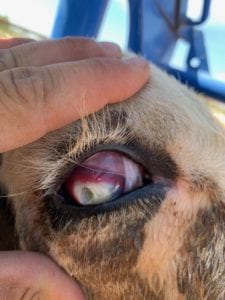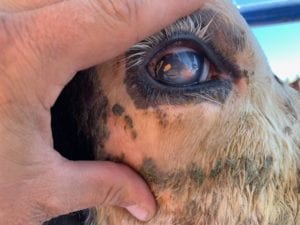Protecting Cattle from Pink Eye – 3 Tips you need to know

Severe livestock pink eye before Curicyn. Photo after using Curicyn Pink Eye Kit below. Picture courtesy of Grant Lindaman
Fly season is just around the corner. If you have cattle, you know flies can create a major problem with pink eye and protecting cattle from pink eye can be difficult. Face flies are attracted to the excessive tearing that occurs at the onset of this very contagious infection. As the face flies travel from one cow to another, so does pinkeye. Once it begins to spread, it’s very tough to isolate, treat, and control. Before you realize it, half of your herd can be infected. Not only is pinkeye painful for cattle, but it can also result in profound weight loss or lack of weight gain in beef calves. Consequently, it is important to 1) take preventative steps ahead of time; 2) recognize the symptoms of pink eye, and 3) when you see symptoms be aggressive immediately.
Protecting Cattle from Pink Eye Tip 1: Take preventative steps
In most cases, the first preventative step in protecting cattle from pink eye is controlling flies. Begin by focusing on breeding sites and eliminating any standing water. In addition, use a safe and effective fly repellent application. Independent testing shows that Curicyn’s Bodyguard Fly Spray is 3 times more effective than other leading fly sprays. Bodyguard is 100% organic, non-toxic to humans and all animals, and comes in 3 sizes. And because it works via the olfactory receptors in the pests, less product is needed on the animal.
Protecting Cattle from Pink Eye Tip 2: Recognize the symptoms
Early treatment is essential in protecting cattle from pink eye so recognizing symptoms is important. The first signs to look for include: tearing and watery eye discharge, aversion to sunlight, and squinting. Also, look for excessive blinking and reddening and swelling of the eyelids and the third eyelid. As the infection progresses, the middle of the eye will become cloudy and eventually turn completely white. Occasionally, the cornea may ulcerate. In rare cases, if left untreated, pink eye can result in blindness.
Protecting Cattle from Pink Eye Tip 3: Treat infected animals

Livestock pink eye 5 days after using Curicyn Pink Eye Kit. 2 Treatments with patches. Picture courtesy of Grant Lindaman
Once you recognize an onset, early treatment can be extremely successful in protecting cattle from pink eye. Curicyn’s Pink Eye Solution is an aggressive, non-toxic product. It is an easy, 1x application process that helps promote healing in 1-3 days.
If the infection is severe, direct sunlight is painful to a pink eye affected animal. It is recommended to protect the eye with an eyepatch. Shielding the infected eye reduces the pain, consequently, the animal is more comfortable and will continue to graze. This will reduce weight loss that is often associated with pink eye. The eyepatch also protects the animal’s eye from dust, debris, and other irritations. Most important, it helps isolate the contamination. The Curicyn Pink Eye Kit is extremely effective for severe cases. The Kit includes everything you need:
- (1) 3oz bottle of Pink Eye Solution (enough for 5 head, 10 eyes)
- (5) Biodegradable, environmentally compatible patches
- (1) Tube of adhesive
- (1) Resealable bag
In conclusion, following these 3 tips for protecting your cattle from pink eye should benefit both you and your cattle. Curicyn’s Bodyguard Fly Spray, Pink Eye Solution, and Pink Eye Kit are the perfect products to have on hand before fly season starts. Bodyguard Fly Spray, together with the Pink Eye Solution and/or the Pink Eye Kit will help decrease the chances of production losses in cattle due to pink eye. In addition, Curicyn’s prices are exceptional. Pick up Curicyn’s Bodyguard Fly Spray, Pink Eye Solution, and Pink Eye Kit at your local Curicyn retailer or order online and get free shipping in the continental US. For more information contact our main office at (800) 467-0547 or email [email protected].
References
Brunori, C. (personal communication, February, 5 2019).
Champness, D., Farquhar, N. (February 2008). Pink eye in beef cattle. Agriculture Victoria. Retrieved from http://agriculture.vic.gov.au/agriculture/livestock/beef/beef-health-and-welfare/pink-eye-in-beef-cattle
Lindaman, G. (personal communication, July 27, 2020).
O’Brien, A. (July 29, 2014). Giving pink eye the stink eye. Pet MD. Retrieved from https://www.petmd.com/blogs/thedailyvet/vheuer/2014/july/giving-pink-eye-stink-eye-31899
Sjeklocha, D. (Apr 01, 2010). How to prevent & treat pinkeye in cattle. Beef. Retrieved from https://www.beefmagazine.com/farm-life/week-agribusiness-jan-19-2019
